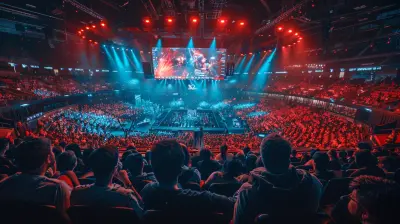The Importance of Communication on the Rugby Field
17 November 2025
When you think about rugby, what comes to mind first? Thunderous tackles? Lightning-fast sprints down the touchline? Maybe a well-timed grubber kick that changes the tide of the game? Yeah, all of that’s part of the game—but there’s one piece that often flies under the radar and yet, holds everything together: communication.
Without communication, even the most skilled team turns into a chaotic mess. You might have the fastest winger, the most powerful prop, or a fly-half with a golden boot, but if they don’t talk to each other effectively, it all falls apart faster than a dodgy scrum.
Let’s dive deep into why communication on the rugby field isn’t just important—it’s absolutely essential.
Why Communication Is the Glue That Holds Teams Together
Imagine this: you're on the field, the opposition’s pressing hard, and the ball is loose. You’ve got milliseconds to make a decision. If no one’s shouting “man on!” or letting you know where the support is... well, good luck with that!Communication is what keeps a team aligned. It’s like the GPS for every player, letting them know what’s around the corner, who’s in position, and what the next move should be.
There are three key types of communication in rugby:
- Verbal communication (think talking, shouting, calling plays)
- Non-verbal communication (gestures, eye contact, body language)
- Emotional communication (team morale, encouragement, leadership presence)
Each one plays a huge role and deserves its own spotlight.
Verbal Communication: The Backbone of On-Field Strategy
Let’s start with the obvious one—talking.Whether it’s the scrum-half coordinating the forwards or the captain barking orders in defense, verbal communication is how players stay connected in a game that moves at breakneck speed.
Callouts: More Than Just Noise
Ever hear a rugby match live? You’ll know it’s LOUD. But all that shouting has purpose. Calls like:- “Inside!”
- “Outside!”
- “Push up!”
- “Line speed!”
…aren’t just random yells. They’re directional cues, timing hints, and warnings all wrapped into one. They keep the team in sync and allow quick reaction without overthinking.
A team that talks—clearly and constantly—is usually the team that controls the pace of the game.
Non-Verbal Communication: Saying Everything Without Words
Sometimes, words just don’t cut it on the pitch. That’s where non-verbal cues come in clutch.A nod, a hand signal, a look. In a split-second environment, these subtle cues provide rapid understanding—like when the fly-half gives a slight flick of the eyes to signal a switch pass, or a lock raises an eyebrow before they shift in the lineout.
Building Trust Without Saying a Word
Non-verbal communication also builds trust. If a player knows exactly what a teammate will do from a look or gesture, it saves time—and in rugby, time is EVERYTHING.These silent messages are built from hours of training together, learning each other’s habits, and understanding body language inside out.
Emotional Communication: The Unsung Hero of Team Chemistry
Alright, let’s talk about the heartbeat of every good rugby side—the emotional connection.Rugby isn’t just brutal; it's exhausting. When your body’s giving up, your lungs are burning, and the opposition just scored, that’s when emotional communication keeps the ship from sinking.
Stay Positive, Stay Connected
Encouragement matters. A simple, “We’ve got this!” or “Next one’s ours!” does wonders. Players feed off each other’s energy, and when one person keeps the spirits high, it spreads like wildfire.Leadership comes into play here, too. A strong captain doesn’t just call plays—they read the room, calm nerves, and rally the troops when morale dips.
Communication in Defense: The Wall Only Stands If Everyone’s Talking
Defensive structure in rugby is like a human chain-link fence. Break one link, and everything falls apart.In defense, communication needs to be sharp, frequent, and crystal clear. Players have to:
- Call their man
- Warn of overlaps
- Organize line speed
- Set the width
The “Talk-Up” Culture
Ever heard a coach screaming, “Talk up! Talk up!” during a defensive drill? That’s because silence in defense is a killer. If you don't know who’s covering inside or outside, you could leave a gaping hole for the opposition to dance through.Great defensive teams are usually the ones that operate like a single organism—every movement is coordinated through constant chatter.
Communication in Attack: Thinking Two Steps Ahead
On the flip side, attacking communication is all about initiative and timing. It’s about finding mismatches, spotting weak shoulders, and making sure the support is right where it needs to be.Play Call Systems
Most teams use code or number systems to communicate plays. Things like:- “Red 3” might mean a crash ball
- “Blue 2” could set up a loop play
- Or a phrase like “Tempo” might signal a quick tap-and-go
Whatever the system, it only works if everyone’s on the same page. That’s where training, repetition, and—surprise—more communication kick in.
Set Pieces: Communication Under Pressure
Let’s talk set pieces. Lineouts and scrums are moments where structure and coordination must be perfect. One wrong move and you lose possession—simple as that.Lineout Calls: The Silent Symphony
Lineouts rely heavily on pre-set calls. The jumper, lifters, and thrower all need to be aligned on:- Who’s jumping?
- Where the throw is going?
- What’s the timing?
Lineout communication might start verbally but ends with synchronized timing. When executed right, it looks almost like ballet. When it’s off—even by a beat—it’s chaos.
Scrum Talk: It’s More Than Grunting
Believe it or not, there’s a ton of talking in the scrum. Front rowers constantly communicate with each other for stability, positioning, and timing. Even locks and back-rowers chime in to help control the push.The Role of the Scrum-Half and Fly-Half: The Team’s Mouthpiece
If rugby had a quarterback role, the 9 and 10 would be it. These two players manage a huge chunk of the game and act as the voice of strategy.- The scrum-half directs forwards, maintains tempo, and delivers rapid instructions.
- The fly-half reads the defense, calls plays, and adjusts the backline’s positioning.
They’re like air traffic controllers—constantly making sure everyone’s in the right place at the right time.
The Coach’s Voice: From the Sideline to the Field
While players do most of the talking on the pitch, clear communication from the coaching staff sets the foundation.Pre-game strategies, halftime adjustments, and in-game messages (often shouted or relayed through water carriers) all shape how the game unfolds. A team that understands the coach’s language and intentions performs with clarity and purpose.
Training for Better Communication: It Doesn’t Just Happen
Here’s the truth: good communication isn’t a natural gift. It’s trained.Great rugby teams spend hours not just working on skills and fitness but also on communicative drills. They simulate game scenarios and practice how to talk, when to talk, and even what to say.
Some drills include:
- Defensive shuffle drills with mandatory callouts
- Set piece rehearsals with coded communication
- Broken play scenarios where players must communicate under pressure
The more a team trains communication as a skill, the more instinctive and effective it becomes.
Gender, Age, and Level: Communication Is Universal
The need for communication spans across every level of rugby:- Men's or women’s
- Youth or professional
- Local club or international elite
No matter who's playing, the principles stay the same. Talk early, talk often, talk smart.
Common Communication Pitfalls (And How to Fix Them)
Let’s be honest. Sometimes communication breaks down. It happens. But knowing why it breaks can help you fix it fast.Some common issues:
- Over-talking: Too many voices confuse more than they clarify. Assign roles.
- Under-communicating: Silence on the field is deadly. Encourage constant feedback.
- Lack of clarity: Slurred or vague calls are worse than none. Keep it sharp and short.
- Emotional shutdown: A bad play or heated moment can shut players down. Build resilience and support from teammates.
Final Thoughts: It’s Not Just What You Say—It’s How You Say It
If there’s one thing to take away from all this, it’s that communication in rugby isn’t just noise—it’s the rhythm, the language, and the heartbeat of the team. It builds trust, creates structure, and fuels momentum.So, the next time you’re watching a rugby game, or better yet, playing in one, listen closely. You'll realize that behind every great play is a conversation—loud, silent, emotional, but always there.
Talk up. Speak clearly. And remember—great teams talk their way to victory.
all images in this post were generated using AI tools
Category:
RugbyAuthor:

Uziel Franco

![The Journey from Small Town to Big Stage: [Player Name]s Inspirational Story](/pictures/blog/small/the-journey-from-small-town-to-big-stage-player-names-inspirational-story_2.webp)